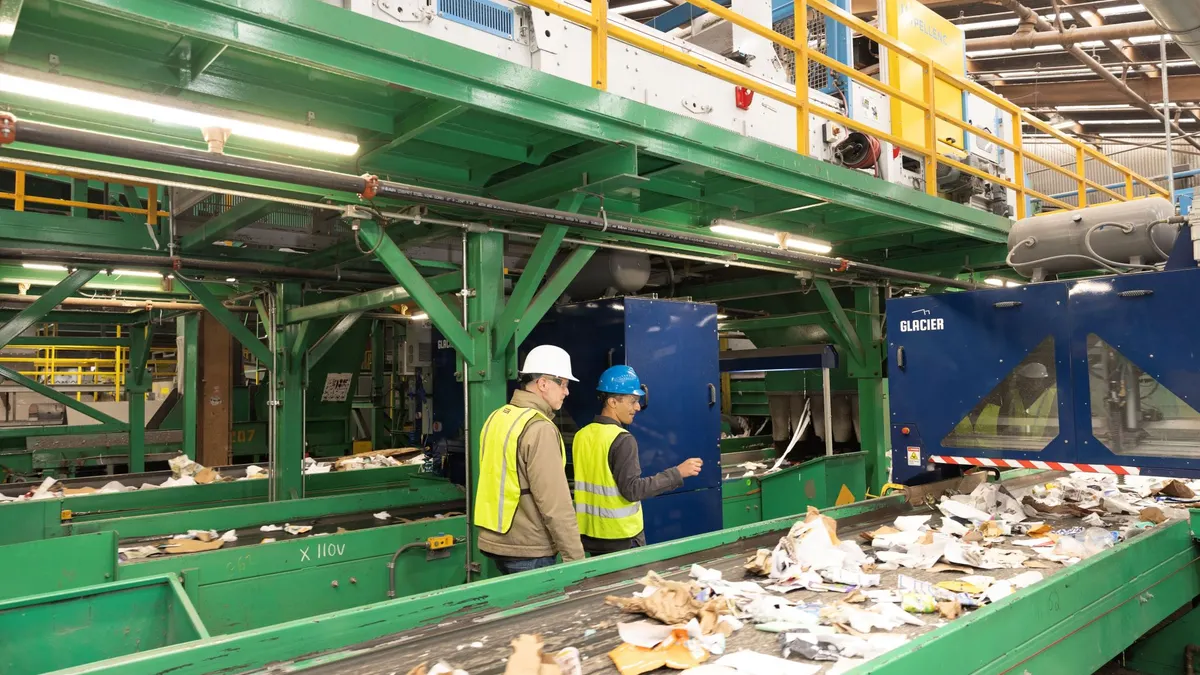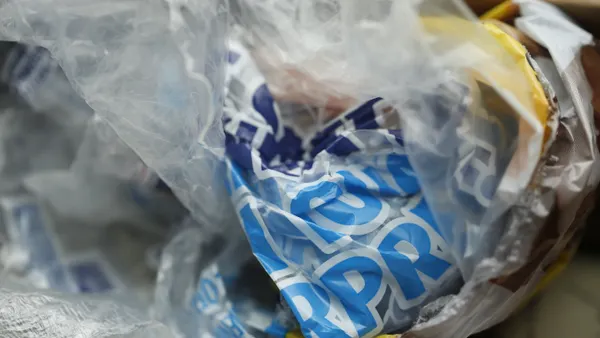China has once again exposed the cracks in an imperfect U.S. recycling system, while creating new motivation to fix them.
In the months since the country announced its latest scrap import policies, most attention has been focused on the Pacific Northwest. Yet after contacting all 50 states, Waste Dive has confirmed that more than one-third of them have experienced notable effects as a result. The details vary, and more are needed, but policymakers and practitioners from around the country clearly agree on at least two things. Contamination is a serious threat to the entire industry and the current economic structure of recycling in many places needs an overhaul.
This isn't the first time that global commodity shifts, usually driven by China, have roiled recycling programs in the U.S. and around the world. Details and predictions about the enforcement of this latest plan change on a near daily basis. Many key players are working to learn as much as possible, but local recycling operations are still having to make do with the current situation as this unfolds.
Local reports
So far, stories about the greatest effects being felt on the West Coast appear accurate. Oregon, Washington, Alaska, Hawaii and Nevada all reported heavy effects for various reasons. Oregon’s Department of Environmental Quality has also granted a small number of disposal waivers, which everyone recognizes is less than ideal.
"We really don't want customers thinking this is our first option," said Kristan Mitchell, executive director of the Oregon Refuse & Recycling Association. "Nobody wants this, but we're kind of stuck right now."
Up in Juneau, AK, Solid Waste Coordinator Jim Penor had seen similar scenarios before during his 40-year career, but felt this one might be more final. "This is way more catastrophic. I almost call this Armageddon for recycling," he said.
In Hawaii, where recycling markets are already tenuous due to the island state's complete reliance on exports, the assistant chief of Honolulu’s refuse division reported the city and county was "holding its own" but viewed the future as uncertain. “It’s really kind of a touch-and-go environment right now," said Mike O’Keefe, recycling branch chief for Honolulu.
Outside of this group, an additional 12 states also reported noticeable effects. Many of those are either in the Midwest or other parts of the country such as New Mexico that ship most of their material out-of-state for processing. The Northeast has also been reporting issues, due in part to preexisting challenges with high disposal costs.
"There’s definitely been an effect in all the states in New England," said Mike Durfor, executive director of the Northeast Resource Recovery Association (NRRA).
According to Victor Horton, executive director of the Maine Resource Recovery Association, markets for rigid plastic in particular are "almost at a standstill."
Down south, states really aren't feeling it as much due to more local end markets. Will Sagar, executive director of the Southeast Recycling Development Council (SERDC), described this latest upheaval from China as less disruptive for commodity prices in his region or the country than others before it.
"Where we've dropped to really isn't amongst the worst places we've been,” said Sagar, while recognizing that they are "not completely immune to it" because some material is exported overseas from Gulf Coast ports.
All of these reports are of course anecdotal and based in part on talking to state environmental agencies that may not always be directly involved in recycling markets. Waste Dive will continue to track these trends and what they mean for all 50 states.
Contamination nation
Above all else, and regardless of market effects, one trend was inescapable when talking to professionals around the country — recycling contamination got the industry here in the first place and it has to be an even greater focus going forward.
While unconfirmed reports are now saying that China may not enforce its originally proposed 0.3% specification after all, in favor of a 1.0% threshold instead, that will still require many programs to clean up their acts. Even before these policies came down, groups such as The Recycling Partnership were working with states including Massachusetts to develop a universal toolkit to address the issue. Companies and local governments have also been trying a variety of new educational tools, but the message hasn't fully sunk in.
"It's like an onerous tax on our operations," said SERDC's Sagar. "We've got to address this contamination issue, and that didn't just happen in August."
Many people that Waste Dive spoke to think this should lead to more realistic messaging from MRF operators and local governments, both in contract language and consumer education.
"The operations managers I don't think feel as empowered as they should to say 'enough's enough,'" said Matt Flechter, recycling market development specialist for Michigan's Department of Environmental Quality.
Flechter said that Michigan wants to create more communication throughout the supply chain to make sure people are putting the right things in their bins and that adequate markets exist to incentivize the capture of those materials.
While few people want to recognize it, some also feel that the rush toward single-stream may be a key culprit. Many executives have touted the attendant safety benefits for workers, and say it's too late to turn back, but others think it's disingenuous to pretend that trend hasn't played a role.
"We have kind of shot ourselves in the foot, in my opinion, by trying to increase recycling volumes and opening up the single-stream curbside service," Penor said of the program in Juneau, adding that none of this is as mysterious as some portray it. "We already know what China wants. China wants the garbage out of the recycling material."
New markets
In response to these new contamination standards, wherever they ultimately land, many MRFs have slowed down their lines and added labor. With the exception of a few that were already planning to invest in new technology, this trend has been reported from coast to coast. Though that response is seen as only a temporary solution
In Oregon, where MRFs are feeling that more than just about anywhere else, one local operator said people need to start thinking longer term.
"We've got to simplify the stream to have any chance to make the new quality requirements," said Dave Claugus, vice president of Pioneer Recycling Services.
Claugus and others said that even higher quality material wasn't necessarily guaranteed to find a profitable home. Chinese import activity has ticked up slightly in November after an early fall pause that was particularly hard on OCC prices, but new licenses haven't publicized yet.
"I think everyone's just way more concerned about what's going to happen in December," said Mike Parkowski, chief of business and governmental services at the Delaware Solid Waste Authority (DSWA).
A common refrain from many state environmental agencies and recycling associations was the desire to expand domestic markets. This was most prevalent among states such as Colorado, Minnesota, Missouri and New Mexico that already have access to some regional options but may be shipping the material long distances to reach them.
For New Mexico, this system has still been holding up in part because many smaller municipalities send their material through a hub and spoke system that doesn't charge processing fees. Material has been moving both within the U.S., and to Mexico, but signs of saturation are already appearing.
"I feel like domestic markets getting flooded has just started to be a real thing in New Mexico," said Sarah Pierpont, executive director of the New Mexico Recycling Coalition.
In the face of this, Pierpont's organization has received national attention for releasing specific guidance to members and she says the best option is to focus on quality.
"We're trying to really promote what we can control," she said. "You can't control what the Chinese government says to the WTO."
What the industry can control
Because the U.S. doesn't have a mandatory recycling policy, and many state environment agencies don’t track markets, much of this discussion has fallen to nonprofits and trade associations. Regional groups such as the NRRA say their work has never "been more important than it is today." National names such as the Institute for Scrap Recycling Industries, Solid Waste Association of North America, National Waste & Recycling Association (SWANA), The Recycling Partnership and the National Recycling Coalition (NRC) have become de facto sources for everyone from city recycling coordinators to the Environmental Protection Agency.
On top of the contamination challenge, many think it's time to start having a more frank conversation with consumers about the cost of recycling.
"American waste generators, both in the business community as well as residents, may have to pay a little more to have their material recycled. If recycling is something that we truly believe in, people should be willing to pay a dollar or two [more] a month," said SWANA CEO David Biderman. "Recycling isn't free, there's people, trucks and infrastructure involved."
That infrastructure and market conversation is also a priority for the NRC, which will be hosting regional workshops and quarterly phone calls on the topic starting in 2018. Executive Director Marjorie Griek said this was already planned prior to China's import escalations and is even more relevant now for the industry’s "long-term health."
"If we can make some real core changes it could really help this industry be less subject to the vagaries of other nations and commodity prices. We could stabilize the market if we take a focused approach and work on it together as an industry," said Griek.
Even in the states such as Oregon that are feeling these market effects the most, there is little disagreement with China’s broader environmental goals.
"Nobody here is complaining about the fact that they’re cleaning up their own world," said ORRA'S Kristan Mitchell.
Whatever happens next, recyclers in multiple states aren't expecting things to return to the way they were, and even though the industry is feeling significant pressure, many think local programs will be better for it in the end.


















